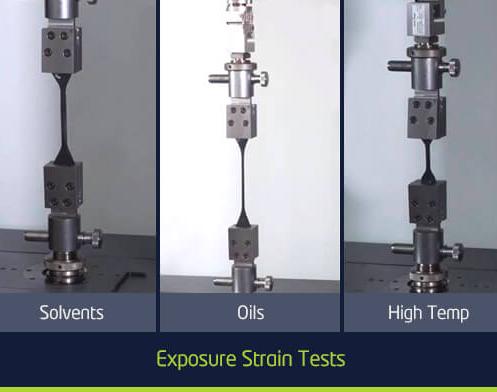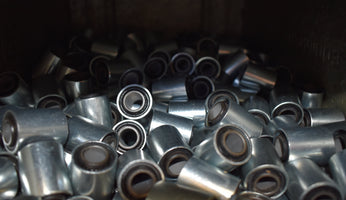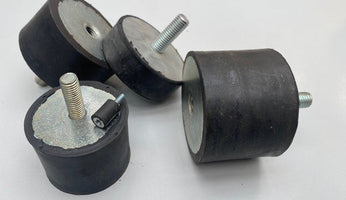Engineering Rubber Materials

Rubber compounds vary, so do operating environments. Why hope that a conveniently available option will work, when you can be confident that a tailored option will?
It’s a fact that every creation is secretly only as good as the sum of its parts. We all know the notion of the weakest link. But all too often the most vital component of a suspension system is given the least amount of thought.
Detail is everything for rubber selection
Take that simple piece of rubber hidden deep within your industrial or automotive project. Pretty inconsequential in the scheme of things? Something that can be bought off the shelf, guaranteed to work and always be ‘right’? After all, rubber is rubber. Right?…
Not so. In our experience the primary cause of product failure can often be traced back to simple rubber selection.

Above: Daniel Lawes showing in a filmed experiment how conditions can impact on the wrong rubber choice.
Rubber is rubber? Well, the main component of any rubber is its base. There are five commonly used base rubbers, but specialists can offer up to 15. Then there are fillers that can strengthen. And fillers that can cheapen. Accelerators and retarders that change the rate of curing. Plasticisers to help materials flow and slide. Protection to shrug off extreme temperatures, ozone, UV light. And even colours and odorisers to make it look and smell good… These all combine to give each rubber a unique personality – one that’s truly tailor-made for just one job.
You may need a perfect seal – a rubber that can bounce back after years of compression. Or a rubber that’s tear and abrasion-proof for use in a traction pad or resilient AV mount.
Then there are the worries of location, extreme weather, exposure to chemicals, flames even…

Above: Adding extreme heat or solvents may make a typically robust rubber considerably weaker. It pays to select suitable properties for the rubber, early in the project.
Advanced rubber chemistry
For example, there’s the work we’ve done with well-known supercar designers. Working with our polymer scientists we devised an exhaust mount capable of withstanding some of the highest temperatures that rubber polymers have ever worked in. We accomplished this thanks to our understanding of advanced rubber chemistry, airflow and heat shields.
Similarly, we identified a no less extreme problem associated with the persistent failure of golf carts in Dubai. The original bushings in the carts suspension simply weren’t up to the extremes of heat and sunlight during the day, blistering cold at night and over-enthusiastic drivers dawn to dusk.
Mis-match a rubber’s ‘personality’ with its purpose and at best you’ll have a failure. At worst a disaster.
Ask us! We can help
Big brands test hundreds of products in extreme locations, but it’s likely that this will be beyond your means. However, you can defend against disaster simply by asking our advice before choosing your rubber product.
To show the kind of unique breaks, scrapes and mistakes that can happen in rubber selection, we made a video. We put different types of ‘seemingly’ similar rubber through a series of extreme tests with surprising results… Check it out when it comes out on our social media channels.

Above: AVMR stretching rubber samples to destruction to guage impact of applied environmental conditions.
Let us get your product right first time. If you’re in need of an extreme solution – no matter how hot, cold, rough, tough or slippery – do give us a call.
Rubber is a widely used material, whether for sealing, vibration absorption, flexibility, coefficient of friction or a combination of these factors. Choosing the right rubber compound is often critical – there are a lot of variables.
The key variable to get right is the base compound, this article focusses on that, and aims to help you understand the options. After this, there are a number of other options, but we will leave those for another time.
Typical properties of a compound specification may include:
- Operating temperature range.
- Ability to resist environmental factors, such as ozone, temperature, interaction with fluids such as water, oils, fuels etc.
- Insulation and absorption of noise and vibration. This opens up a wide range of follow on questions.
- Friction (which is challenging to get right first time round)
- Whether it can be used in direct contact with food, or not.
- Whether it can be bonded.
- Ability to conduct or insulate heat and electricity.
- High or low tear resistance.
- Strength and elasticity
Rubber compounds are often designed around a requirement. A requirement can use a material that we already stock, however sometimes we need to design something specific. This process is fairly painless as long as we understand the key factors of the application, and how the product is to be produced e.g. injection moulded, compression moulded, extruded, in an autoclave, or one of the less common approaches.
What are the benefits of using Rubber?
Some benefits of using rubber include the following list. Not all rubbers can achieve all of the below, but if the important parts are specified they can be built in to the design:
- Wide operating temperature range: -60°C – 300°C (but not continuously)
- Colours can be whatever you require, as long as it has a colour. However, some limitations exist depending on the rubber type and what you want to use it for.
- Hardness, which has a correlation to strength.
- Electrically insulating, conductive or anti-static
- They can be flame extinguishing or flame retardant, but they can also be flammable unless otherwise specified.
- Ability to maintain a seal
- Resistance to interaction and degradation from ozone, liquids, gases & heat
- Resistance to abrasion, tearing, or tear/cut propagation
- It can be smooth and easily cleaned, which is important for hygienic related applications.
- It can be food safe, and used in direct contact with food.
It is important to understand how a compound is going to be used, and which properties matter most. With that information, AVMR can start to develop the right compound
Refining the compound
It is important to select the correct base rubber compound to ensure the properties are in the correct area for the application. However, there are further aspects of the rubber which will impact performance.
Certain additives may be required to improve environmental resistance (e.g. ozone, weather), physical properties, or to improve temperature resistance. Other additives can improve tear resistance or help compounds meet fire retardant requirements, which are important for the rail industry.
AVMR have developed compounds which can withstand higher temperatures than standard ones, and we have a specific track pad compound with high abrasion and friction requirements.
The important point is that the table is a guide only.
Why not call us or send us your enquiry for a more detailed perspective.
If you need advice, please drop us a line at sales@antivibrationmethods.co.uk or Tel: +44(0) 1985 219 032. We’re happy to help.

